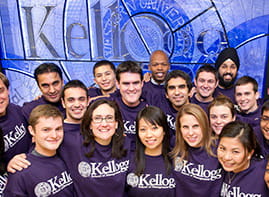Executive guest Peter Burton brings real-world perspective to augment classroom theory; explains why firm walked away from some large national retailers
2/13/2008 - Why is the world’s number one selling brand of chain saw not sold in Lowe’s or The Home Depot?
That headline is lifted verbatim from what is fast becoming a legendary ad campaign. One of the chief architects of that campaign and of the marketing strategy that underlies it — Peter Burton — visited the Kellogg School Jan. 31 to answer the question for students in
Richard Wilson’s marketing channels class.
Burton is vice president of sales and marketing for Stihl USA, and a long-legged Australian who made his points in a friendly, funny and persuasive way during his Kellogg appearance. Stihl USA is the North America arm of an 80-year-old family owned German manufacturing company. Stihl (pronounced Steel) produces not only the world’s top-selling brand of chain saw, but a range of weed whackers, hedge trimmers, leaf blowers and other handheld outdoor power equipment.
Three years ago Burton and his colleagues made the tough decision not to sell their products at the two “big box” retailers, Lowe’s and The Home Depot, and have kept them out of Wal-Mart and Sears too. “The category killers are tempting,” Burton acknowledged. “It’s easy to get caught up in the adrenaline rush when they come calling. The kind of volume they say they can deliver, it’s huge.”
So why would Stihl shut the door on distribution channels that reach a significant portion of end-consumers?
“The big boxes are also intimidating,” he told students. They dictate guarantees and shift costly operational activities off their own backs and onto suppliers. And they expect their suppliers not just to hold down their prices but to consistently drop them annually. In short, the supplier is left helpless and increasingly profitless. “If you sleep beside the 800-pound gorilla, you don’t want to be caught underneath when it rolls over,” said Burton.
But the real reason Stihl cut ties with these national retailers was their inability to provide consumers with the right customer experience. Stihl had cultivated a network of over 8,000 independent specialty dealers who took pride in providing their customers with the full range of high-touch services and education required to make the right purchase — and use the product safely. Burton and his colleagues felt that distributing in the home centers would eventually undermine Stihl’s quality reputation and brand image with consumers.
And, said Burton, Stihl wanted to make it clear to its dealers that while competitors were being seduced by volume, their loyalty to their long-time partners was firm. They would burn their bridges to mass merchants. “We’re putting all our eggs in one basket: our specialty dealers,” said Burton, “and we make sure our dealers succeed financially.” The value of this support has been so high that more than 55 percent of Stihl’s specialty dealers are exclusive in return. “Our dealers tell us they make more money and lose fewer sales carrying only Stihl.”
Leaving a legacy of trustworthiness is important to Peter Stihl, the company’s 75-year-old patriarch. That integrity is apparent in the disciplined channel strategy and leadership in the face of a rush to low-price mass channels. The U.S. group was recommitting — very publicly — to both its specialty dealers and its end customers, noted Burton.
To drive his message home for his Kellogg audience, Burton brought along a 30-second television ad. It shows a fresh-faced home-center employee getting quick instruction from a Stihl dealer on how to start a chain saw. The employee then free-runs over link fences and packing crates back to the home center, where he has left a customer waiting while the intrepid employee went off to get the answer he’d never been trained to give. As the young clerk races breathlessly up, the customer stabs a toilet plunger in his chest, turns on his heel and heads directly over to the Stihl dealer, finishing the spot with a purchase and a smile.
Stihl’s strategy has been right so far. Sales have taken off, even while growth at the giant home centers has faltered.
Wilson, a Kellogg marketing lecturer and Burton’s host at Kellogg, sees manufacturers like Stihl in the vanguard of a consumer markets channel correction away from efficiency, one-size-fits-all and low prices to more attention to improved channel effectiveness and more exciting customer experiences.
But Wilson cautioned after the talk that it would be a mistake to see exclusive specialty channels like Stihl’s or aggressive forward-integration (such as Apple retail stores) as manufacturers’ next big thing.
“There are no pat answers,” said Wilson. “You have to segment your customers, figure out the right bundle of tangible service outputs to deliver, develop compelling value propositions — segment by segment — cost it all out and do the division of labor among channel partners in an economically rational, operationally practical way. That’s hard analytical work.”
Burton does not disagree.
“A strategy is about being different
in an important way. Our messaging highlights that difference,” he said. “That’s why I think growth through our high-value specialty dealers is potentially unlimited.”






